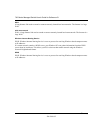
700 Series Managed Switch User’s Guide for Software v2.1
Glossary
5
SM-10004-02
Filtering
The process of screening a packet for certain characteristics, such as source address, destination address, or
protocol. Filtering is used to determine whether traffic is to be forwarded, and can also prevent unauthorized
access to a network or network devices.
Flow control
A congestion- control mechanism. Congestion is caused by devices sending traffic to already overloaded
port on a switch. Flow control prevents packet loss and temporarily inhibits devices from generating more
traffic until the period of congestion ends.
Full-duplex
A system that allows packets to be transmitted and received at the same time and, in effect, doubles the
potential throughput of a link.
Gateway
A local device, usually a router, that connects hosts on a local network to other networks.
Gigabit Ethernet
An Ethernet system that is designed to operate at 1000 Mbps (1 Gbps).
Half-duplex
A system that allows packets to transmitted and received, but not at the same time. Contrast with
full-duplex.
IEEE
Institute of Electrical and Electronics Engineers. This American organization was founded in 1963 and sets
standards for computers and communications.
IETF
Internet Engineering Task Force. An organization responsible for providing engineering solutions for TCP/
IP networks. In the network management area, this group is responsible for the development of the SNMP
protocol.
IGMP
Internet Group Management Protocol, the standard for IP multicasting in the Internet. IGMP is used to
establish host memberships in multicast groups on a single network. (See IP multicast)
IP
Internet Protocol is the main internetworking protocol used in the Internet. Used in conjunction with the
Transfer Control Protocol (TCP) to form TCP/IP.
IP Address
A four-byte number uniquely defining each host on the Internet, usually written in dotted-decimal notation
with periods separating the bytes (for example, 134.177.244.57).


















